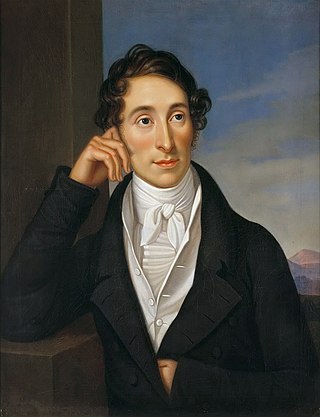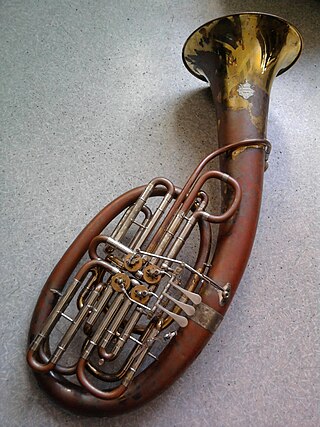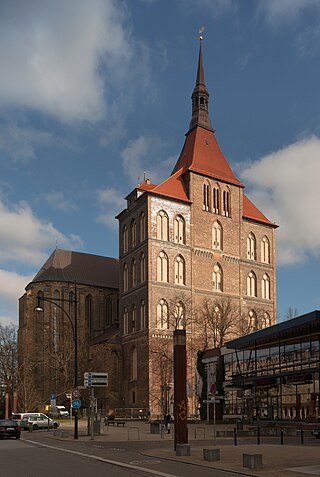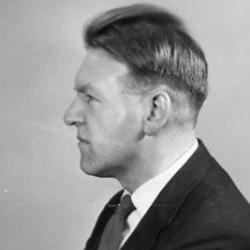
Carl Maria Friedrich Ernst von Weber was a German composer, conductor, virtuoso pianist, guitarist, and critic who was one of the first significant composers of the Romantic era. Best known for his operas, he was a crucial figure in the development of German Romantische Oper.

A composer is a person who writes music. The term is especially used to indicate composers of Western classical music, or those who are composers by occupation. Many composers are, or were, also skilled performers of music.

The Wagner tuba is a four-valve brass instrument named after and commissioned by Richard Wagner. It combines technical features of both standard tubas and French horns, though despite its name, the Wagner tuba is more similar to the latter, and usually played by horn players. Wagner commissioned the instrument for his four-part opera cycle Der Ring des Nibelungen, where its purpose was to bridge the acoustical and textural gap between the French horn and trombone.
Music theatre is a performance genre that emerged over the course of the 20th century, in opposition to more conventional genres like opera and musical theatre. The term came to prominence in the 1960s and 1970s to describe an avant-garde approach to instrumental and vocal composition that included non-sonic gesture, movement, costume and other visual elements within the score. These compositions were intended to be performed on a concert hall stage, potentially as part of a longer programme of pieces. Since the 1980s, the term music theatre has come to include any live project that uses the techniques and theories of avant-garde theatre and performance art to experiment with new ways of combining music and theatre; this has been extended to include some of the historical works that influenced the music theatre of the 1960s, such as Arnold Schoenberg’s Pierrot lunaire (1912), Igor Stravinsky’s L'Histoire du soldat (1918) and Kurt Weill’s Mahagonny-Songspiel (1927). The unconventional scale and unfamiliar aesthetic language of this work often positions it outside of the established traditions, institutions and discourses of opera and musical theatre. For this reason, the genre has also been called new music theatre and experimental music theatre.
The year 1629 in music involved some significant events.

Die drei Pintos is a comic opera of which Carl Maria von Weber began composing the music, working on a libretto by Theodor Hell. The work was completed about 65 years after Weber's death by Gustav Mahler. It premiered on 20 January 1888 at the Neues Stadttheater in Leipzig.
George Michael Sinclair Kennedy CBE was an English music critic and author who specialized in classical music. For nearly two decades he was the chief classical music critic for both The Daily Telegraph (1986–2005) and The Sunday Telegraph (1989–2005). A prolific writer, he was the biographer of many composers and musicians, including Vaughan Williams, Elgar, Barbirolli, Mahler, Strauss, Britten, Boult and Walton. Other notable publications include writings on various musical institutions, the editing of music dictionaries as well as numerous articles for The New Grove Dictionary of Music and Musicians and the subsequent Grove Music Online.

St. Mary's Church, Rostock, in German Marienkirche, is the biggest of three town churches found in the Hanseatic city of Rostock, in northern Germany. The other two are St. Peter's (Petrikirche) and St. Nicholas (Nikolaikirche). A fourth, St. James' (Jakobikirche), was heavily damaged during the Second World War and subsequently demolished. St. Mary's was designated in 1265 as the main parish church. Since the Protestant Reformation in 1531, it houses a congregation of the Evangelical Lutheran State Church of Mecklenburg.

John Thomas Douglass (1847–1886) was an American composer, virtuoso violinist, conductor and teacher. He is best known for composing Virginia's Ball (1868), which is generally regarded as the first opera written by a Black American composer. The work is now lost, and his only extant composition is The Pilgrim: Grand Overture (1878) for piano. His biography from James Monroe Trotter's Music and Some Highly Musical People (1878)—in which The Pilgrim survives—reports that he wrote many now lost pieces for piano, orchestra and particularly guitar, which he was known to play.

Catone in Utica is an opera libretto by Metastasio, that was originally written for Leonardo Vinci's 1727 opera. Following Vinci's success, Metastasio's text was used by numerous composers of the baroque and classical eras for their own operas, including Pietro Torri (1736), Antonio Vivaldi (1737), Giovanni Battista Ferrandini (1753) and J. C. Bach (1761).

The Volkstheater Rostock is the municipal theatre of the Hanseatic city of Rostock. It has three venues: the Großes Haus, the Theater im Stadthafen and the Kleine Komödie and puts on plays, musical theatre/opera, ballet and orchestral concerts. Norddeutsche Philharmonie Rostock is the orchestra for musical theatre and concerts. There is a children's theatre and a theatre youth club.
Daniel Friderici was a German cantor, conductor, and composer.

The Ospedale degli Incurabili is a large sixteenth-century hospital building on the Fondamenta delle Zattere, in the sestiere of Dorsoduro, in Venice in north-eastern Italy. Today it is occupied by the Accademia di Belle Arti di Venezia. It was built in the second half of the sixteenth century; the church – which no longer exists – may have been designed by Jacopo Sansovino.
Nikolaus Hasse, sometimes spelled Nicolaus Hasse, was a German composer and organist of the Baroque period. Part of the Hasse family of musicians, he was the son of Peter Hasse. A longtime organist at St. Mary's Church, Rostock, he is best remembered today for his compositions of chamber music and sacred songs.

Gilbert Reaney was an English musicologist who specialized in medieval and Renaissance music, theory and literature. Described as "one of the most prolific and influential musicologists of the past century", Reaney made significant contributions to his fields of expertise, particularly on the life and works of Guillaume de Machaut, as well as medieval music theory.
Valentin Haussmann was a German composer, music editor and poet, known from the publications of his compositions, derived from Italian and Polish models.
Nicola Sabini was an Italian composer of the mid-Baroque period who spent his career in Naples. An influential figure in early Neapolitan opera buffa, his most important opera is the 1701 comedy Scherzo drammatico, Il mondo abbattuto.

The Stadttheater Rostock, sometimes referred to as the Rostocker Stadttheater, was a theatre in Rostock, Mecklenburg-Vorpommern, Germany. Designed by architect Heinrich Seeling, it was built in 1894. The theatre opened to the public in 1895, and was the largest theatre in the city of Rostock until it was destroyed in an air raid in 1942 during World War II. The theatre served as the city's primary opera house in addition to hosting other kinds of performances on occasion.











